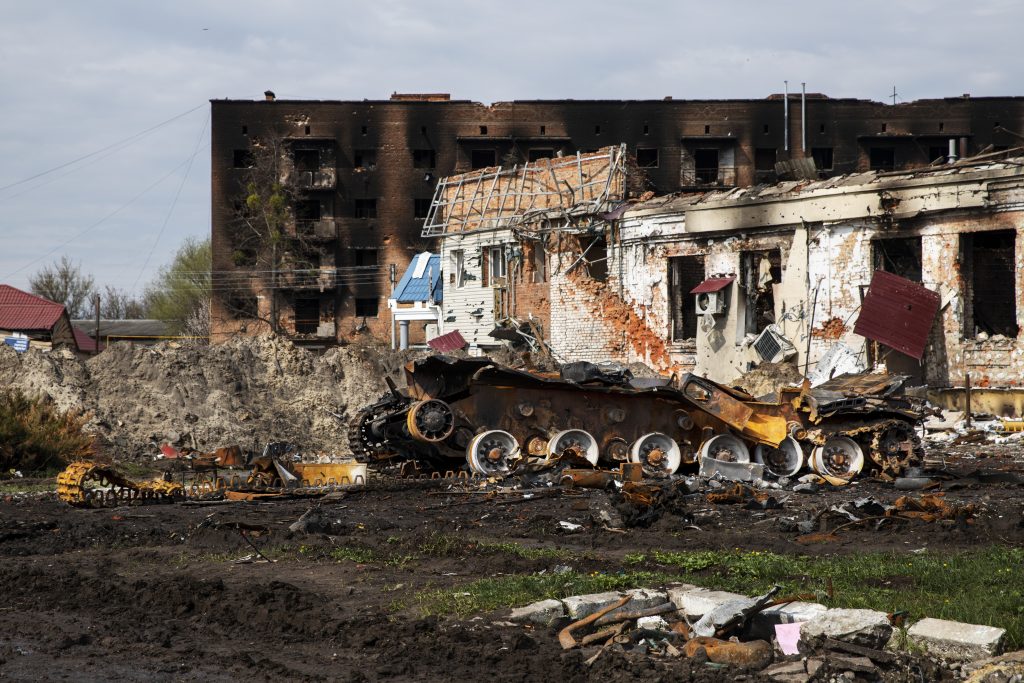Are you wondering about the perilous plight of Ukraine’s nuclear power facilities amid the Russia-Ukraine war? This article delves into the consequences of the ongoing conflict and explores the risks faced by these critical sites. In February 2022, the Russian offensive saw the seizure of the Chernobyl nuclear power plant and the Zaporizhzhiaplant by Russian forces. While the reactors were unharmed during the attacks, concerns about the safety and security of these facilities have arisen. The International Atomic Energy Agency (IAEA) has been closely monitoring the situation and providing assistance, stationing teams at Ukrainian nuclear plants since January 2023. Ukraine has grappled with widespread blackouts, impacting electricity availability and the country’s energy system. This article examines the legal protection measures surrounding nuclear power plants and emphasizes the need for responsible behavior to mitigate risks. Stay tuned to learn more about the repercussions of attacks on nuclear power plants and the international community’s role in ensuring their safety.
Russian Offensive and Attacks on Facilities
One of the key impacts of the Russia-Ukraine war on Ukraine’s nuclear power facilities is the takeover and control of the Chernobyl and Zaporizhzhia plants by Russian forces. This has necessitated a thorough impact assessment of the situation, with a focus on safety measures, strategic risks, responsible behavior, and consequences mitigation. The safety and security of these facilities are of utmost concern, as any breach could result in severe consequences.
The takeover of the Chernobyl plant by Russian forces raises significant concerns regarding the release of radioactive material. However, it is important to note that no such release has occurred thus far. The International Atomic Energy Agency (IAEA) is closely monitoring the developments at the Chernobyl plant to ensure the situation remains under control.
Similarly, the Zaporizhzhia plant has also come under Russian control, but fortunately, the reactors have not been affected. Nevertheless, the presence of two separate sets of nuclear operators at these facilities raises concerns about command-and-control processes.
In order to address the risks posed by the Russian offensive and attacks on these facilities, responsible behavior is crucial. Both sides must refrain from using nuclear power plants for tactical advantages. Additionally, establishing non-attack agreements, similar to those between India and Pakistan, could contribute to the overall safety and security of these facilities.
Efforts must also be made to mitigate the potential consequences of attacks on nuclear power plants. Strengthening physical security, enhancing intelligence and surveillance capabilities, implementing emergency response plans, and improving international cooperation are essential steps in this regard.
International Atomic Energy Agency (IAEA) and Chernobyl Nuclear Power Plant
The role of the International Atomic Energy Agency (IAEA) in relation to the Chernobyl Nuclear Power Plant during the Russia-Ukraine war is of critical importance. The IAEA has been actively involved in conducting safety assessments and providing assistance in Ukraine. In terms of the Chernobyl Nuclear Power Plant, the IAEA was informed about the situation and closely monitored the developments. Safety assessments were conducted to ensure that there was no release of radioactive material during the takeover of the plant by Russian forces. The IAEA’s involvement in conducting radiological assessments is crucial in determining the potential radiological consequences and ensuring the responsible behavior of all parties involved. Additionally, the IAEA plays a significant role in ensuring the physical security of nuclear facilities, including the Chernobyl Nuclear Power Plant. By stationing teams of experts at Ukrainian nuclear plants, the IAEA is able to provide continuous monitoring and assistance to mitigate risks and address any potential security concerns. The IAEA’s involvement in Ukraine’s nuclear power facilities is essential to ensure the safety and security of these facilities amidst the ongoing conflict.
Impact on Ukraine’s Energy System
Widespread blackouts have significantly impacted Ukraine’s energy system amidst the ongoing Russia-Ukraine war. These blackouts have had a severe impact on the electricity supply in the country, leading to disruptions in the energy infrastructure. The external power supply to all four of Ukraine’s nuclear power plants has been affected, raising concerns about energy security.
To provide oversight and monitoring, the International Atomic Energy Agency (IAEA) has had a permanent presence at all of Ukraine’s nuclear power plants since January 2023. The IAEA plays an important role in assessing the situation and providing regular updates on the developments at these facilities.
To give you a better understanding of the impact on Ukraine’s energy system, here is a table summarizing the key points:
| Impact on Ukraine’s Energy System | |
|---|---|
| Impact on electricity supply | Widespread blackouts have occurred in Ukraine, affecting the power supply to nuclear plants. |
| Blackouts in Ukraine | The blackouts have significantly disrupted the energy system in the country. |
| Energy infrastructure disruptions | The energy infrastructure has been severely affected by the ongoing conflict. |
| IAEA’s role in monitoring | The IAEA has been closely monitoring the developments at Ukraine’s nuclear power plants. |
| Energy security concerns | The blackouts raise concerns about the energy security of Ukraine. |
These disruptions in Ukraine’s energy system highlight the vulnerability of critical infrastructure during times of conflict. It is crucial for the international community to support Ukraine in restoring its energy supply and ensuring the safety and security of its nuclear power plants.
Zaporizhzhiaplant Attack
Russian forces took control of the Zaporizhzhiaplant in Ukraine during the ongoing Russia-Ukraine war. This attack on the Zaporizhzhiaplant raises several discussion ideas:
- Security measures:
- Assessing the effectiveness of security measures in place at the Zaporizhzhiaplant.
- Analyzing the vulnerabilities that allowed Russian forces to take control of the plant.
- Evaluating the response and readiness of the plant’s security personnel.
- Potential consequences:
- Examining the potential consequences of the attack, including the risk of a major nuclear accident.
- Assessing the impact on the surrounding environment and population in case of a radioactive release.
- Analyzing the short-term and long-term effects on Ukraine’s energy system, including electricity availability and stability.
- IAEA response:
- Investigating the role of the International Atomic Energy Agency (IAEA) in monitoring and responding to the attack.
- Assessing the actions taken by the IAEA to ensure the safety and security of the Zaporizhzhiaplant.
- Analyzing the IAEA’s assessments and measures to stabilize the situation at the plant.
- Implications for Ukraine’s energy system:
- Evaluating the impact of the attack on the overall functioning of Ukraine’s energy system.
- Analyzing the implications for the country’s energy security and the ability to meet domestic electricity demand.
- Assessing the measures taken by Ukraine to mitigate the effects of the attack and restore the normal functioning of the plant.
- International cooperation:
- Examining the role of international cooperation in addressing the aftermath of the attack.
- Analyzing the support provided by other countries and international organizations to assist Ukraine in dealing with the situation.
- Assessing the importance of collaboration and information sharing to enhance the security of nuclear facilities worldwide.
These discussion ideas highlight the need for a thorough analysis of the Zaporizhzhiaplant attack, its potential consequences, and the response from both Ukraine and the international community. Strengthening security measures, addressing the implications for Ukraine’s energy system, and promoting international cooperation are essential for ensuring the safety and security of nuclear power facilities in times of conflict.
Timeline of Key Events
As we delve into the timeline of key events surrounding the impact of the Russia-Ukraine war on Ukraine’s nuclear power facilities, it is crucial to understand the sequence of significant occurrences. The following table provides a summary of these events:
| Date | Event |
|---|---|
| February 24, 2022 | Ukraine disconnected its grid from Belarus and Russia and requested emergency synchronization to the European power grid. |
| February 24, 2022 | Ukraine informed the IAEA about the takeover of the Chernobyl nuclear plant by Russian forces. |
| March 2, 2022 | Russia informed the IAEA about its control over the territory around the Zaporizhzhia nuclear plant. |
| March 3, 2022 | The State Nuclear Regulatory Inspectorate of Ukraine reported the breach of a block-post near the Zaporizhzhia plant by Russian tanks and infantry. |
These events highlight the rapid escalation of the conflict and the impact it has had on Ukraine’s nuclear power facilities. The Ukrainian power grid was disconnected from Russia and Belarus in an effort to ensure the stability of the system. The takeover of the Chernobyl nuclear plant by Russian forces raised concerns about the potential release of radioactive material. Similarly, the breach near the Zaporizhzhia plant by Russian tanks and infantry posed a threat to the physical integrity of the facility.
Throughout these events, the International Atomic Energy Agency (IAEA) has played a crucial role in assessing the situation and providing assistance. The IAEA was informed about the takeover of the Chernobyl plant and has been closely monitoring the developments there. The IAEA has also been informed about the situation at the Zaporizhzhia plant and is closely monitoring it as well.
These events highlight the vulnerabilities of Ukraine’s nuclear facilities in a war zone and the importance of the international legal framework in protecting them. The IAEA assessments and actions are essential in ensuring the stability of the Zaporizhzhia plant and preventing any potential accidents with radiological consequences. The international community must continue to reinforce responsible behavior and strengthen diplomatic efforts to prevent conflicts in sensitive regions to avoid further endangerment of nuclear facilities.
Risks Faced by Nuclear Facilities in War Zones
Nuclear facilities in war zones face significant risks to their safety and security. These risks can have severe consequences for both the operation of the reactors and the surrounding environment. Here are some key points to consider:
- Vulnerability assessment: The presence of armed conflict in the vicinity of nuclear facilities increases their vulnerability to attacks and sabotage. It is crucial to assess and address these vulnerabilities to ensure the safety of the facilities.
- Reactor operations: The ongoing war can disrupt the normal operations of nuclear reactors. Power cuts, damage to infrastructure, and the loss of electricity availability can pose significant challenges to the safe and efficient operation of the reactors.
- Strategic risks: The use of nuclear facilities for tactical advantages by both sides in the conflict raises concerns about the strategic risks involved. The potential release of radioactive materials and the threat to public health and the environment are among the major risks that need to be mitigated.
- Command and control processes: The control and management of nuclear facilities become more complex in a war zone. The presence of separate sets of nuclear operators, as seen in Ukraine, can raise concerns about the effectiveness of command and control processes, which are crucial for ensuring the safety and security of the facilities.
Role of the International Atomic Energy Agency (IAEA)
The International Atomic Energy Agency (IAEA) plays a crucial role in assessing the risks faced by nuclear facilities in war zones, including the ongoing conflict between Russia and Ukraine. The IAEA’s involvement in this situation has been significant, with its experts conducting safety, security, and radiological assessments in Ukraine. Since January 2023, the IAEA has had teams stationed at Ukrainian nuclear plants, providing regular updates on the situation.
One of the key responsibilities of the IAEA is to ensure the protection of nuclear facilities. In the context of the Russia-Ukraine war, this involves evaluating the physical integrity of the facilities and identifying any violations. The IAEA has identified violations of the physical integrity of the Zaporizhzhia plant, highlighting the need for enhanced protection measures.
In addition to its assessments, the IAEA also promotes international cooperation in nuclear facility protection. This includes sharing best practices, conducting regular safety assessments and audits, and improving information sharing between countries. By fostering responsible behavior and cooperation among nations, the IAEA aims to mitigate the risks faced by nuclear facilities in war zones.





